
Primary Image Ltd 3dfx products

Primary Image (Graphics) Ltd specialized in the design and development of high-performance PC-based image generators for use in all training and simulation applications. The company, whose products included Piranha, Barracuda, P10+ and the Tempest API, now offered some of the most advanced and cost-effective visualization solutions available.
Primary Image was established in 1978 to fulfill the need for realistic image processing, data management and real-time graphics solutions. One of Primary Image's first customers was Toshiba Medical in Japan, which required an Array Processor for the high-speed processing of CT X-ray body scanners. Other projects requiring leading edge technology, such as PIPE (Parallel Image Processing Engine) and DIAMOND (Direct Image AssessMent on DemaND) soon followed.
In 1992, the company divided its resources equally between the Image processing and Graphics divisions so that it could develop new skills and concentrate on meeting the exact demands of customers. These divisions traded independently under the names Primary Image (Vision Systems) Ltd and Primary Image (Graphics) Ltd.
Unfortunately in September of 2005 Primary Image (Graphics) went into receivership and is no more.. However a large group of Primary-Image employees bought out Primary Images assets and formed a new company which is called XPI Simulation. 70% of XPI's staff are former Primary-Image personal.
XPI managing director Simon Skinner states: “There is a clear need for the technology we have. We are very dynamic and have a host of new ideas we are already working on. We are looking at selling a lot more of our Tempest software and more of the small-scale complete simulation systems that Primary Image Graphics offered.”
3dfx related: Primary Image was one of the first companies to utilize Voodoo Graphics and Voodoo II chipsets for the visual simulation markets and till this day the ONLY company to field those chipsets unitizing three onboard texture management units. Primary Image had to stop using 3Dfx chips after Voodoo2 because 3Dfx signed there agreement with Quantum3D for them to be the sole source for later generations of 3Dfx based systems in the Visual Simulation field.
Some history from Alan Davenport of XPI
We started in 1978 when the company was called Akebia Ltd. Initially developing soft scroll monitors for financial dealing rooms. In 1981 I took responsibility for starting the 3D graphics side of the company and Geoff Thiel headed up the Image Processing side. The IP division developed some very high speed hardware for Toshiba medicals CT scanners and followed on to recognition systems for the military and finally security vision systems changing its name to PI Vision Ltd on the way.
Primary Image (Graphics) first system in 1985 was called BEST using AMD 2901 bit-slice processors on non-standard boards. This was later superseded by the VME based AGE (Advanced Graphics Engine) which was based on AMD's QPDM graphics processor.
Stride was the company's first PC based board using Texas Instruments TMS34020 range of components: As with all Primary Image products it had both the graphics chip plus either one or two additional TMS34082 floating point processors to cope with the geometry processing. It also had an add on board utilizing a number of Toshiba's TC8512 Gouraud Shading Pocessors. This made it the first PC based graphics card capable of real time Gouraud shading & anti-aliasing. This additional processing is why we differentiated Primary Image products as Image Generators and not just graphics cards that competitors called Image Generators. Another trade mark was scalability such that the hardware would could be chain linked to provide higher performance.
The second PC product was P10 based on the ISA bus using Texas Instrument TMS320C80 (MVP) components for the graphics. P10 was largely backward compatible with STRIDE but had the additional advantage of using multiple boards to control a single screen and dynamically allocate the regions in real time. P10 was probably the first PC board to do texturing as well.
P10 was replaced by Piranha and subsequently by Barracuda.We had a great deal of respect for the engineers at 3DFX. After Barracuda was Fabriano which was essentially 4 PC's each with an NVidia graphics card housed in a 5U chassis and synchronized internally by a custom FPGA.
(Some technical corrections made to above on 7/11/06)
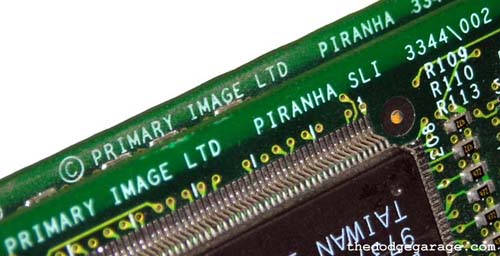
PIRANHA: By offering an unprecedented level of speed, power and realism, Piranha was the first ever PC-based image generator able to compete with more expensive and complex workstations. It's popularity in the simulation and training industry remains undisputed as it continues to provide the performance, special effects and price required by most applications.
Piranha info via 1997 issue of The WAVE Report The 8-card system is the maximum expected for a system. All cards are PCI and there is priority interconnect system between cards. Piranha can scale either in performance as outlined above or scale in the number of channels with multiple cards. An entry card includes 32MB of memory and sells for approximately $6,000. A module is available for the PCI card which will double the rendering performance. The memory is expandable to 64MB. A fully loaded card costs $9,000.
The 3Dfx Voodoo technology is used to just accelerate the pixel rendering process.
Anti-aliasing is supported on textures which can be either bilinear or trilinear filtered. Software based polygon edge anti-aliasing is also supported. For full screen sub-pixel anti-aliasing up to 4 or 8 sub-pixels are used.
Display resolutions supported range from 640 X 480 to 1024 X 1280. To support multiple channels genlock is included.
In 1998 a calligraphic light option, important for the simulation community, will be supported with a hardware add-on module.
To support this new platform Primary Image will be announcing a software product called TEMPEST CGI – a high-level simulation application development environment. This is based on its current CGI software. TEMPEST CGI is their implementation of what they call Open Enhancement Technology. This enables their products to support OpenGL and Glide. They are also planning on a low-cost modeling tool based on AutoCAD and a fast prototyping environment. OpenFlight is also supported.
Piranha manual PDF download here.
BARRACUDA: Barracuda is the number one IG solution as it offers dramatic technological advances over all existing PC-based IGs. Barracuda extracts the very best performance from any application and provides a number of unique and key benefits. The advanced simulation features and high definition images ensure maximum realism for all training applications.
Notes from Paul Slade, former Primary Image employee: In November 1998 Barracuda was released. This was similar to Piranha with the following updates - The Mips processor was upgraded to a 300MHz R7000. The Voodoo chips were upgraded to Voodoo 2, still 2 FBI and 6 TMU with the daughter card. An additional bus was added to optionally allow the geometry processing to be performed by a separate card (called Cruncher) which had two 300MHz MIPS R7000's. The Cruncher would broadcast the polygon data to all the Barracuda's in a single channel by DMAing to a memory window. The local R7000 on each Barracuda would read the polygon data, add it's own local sub-pixel offset for anti-aliasing, then send the draw commands to the Voodoo 2 chips. A Galileo PCI bridge was added so that the 3Dfx graphics chips were visible on the PC's PCI bus (on Piranha the PC could not directly access the Voodoo chips). Multi-card configuration options were the same as Piranha.
These boards were used primarily for running Tempest which is Primary Images scene manager software. In Tempest all the scene graph processing and draw call code is run on the embedded MIPS processor on the Baracuda card itself. There was an embedded version of the Glide driver that allowed the MIPS processor to talk directly to the 3Dfx chipset. Some parts of Tempest ran on the PC, such as the API, database loading, communication with the Barracuda cards, etc. However, the 3Dfx chipset also appeared on the PC's PCI bus so it was possible to use it in the conventional manner.
Barracuda PDF download here.
Barracuda manual PDF download here.
Barracuda tech specs download here.
More Barracuda info via 1998 issue of The WAVE Report
Performance highlights include:

CRUNCHER: Cruncher is a plug-in PCI expansion card, which offers enhanced performance for Barracuda image generators and is designed so that it can be added into existing systems as well as being supplied with new systems as an option. Cruncher has been designed to overcome many of the criticisms leveled at the PC architecture with respect to high-end simulation and training. Many of today's visual simulation requirements demand greater scene density and increased update rates. Cruncher provides a very high polygon throughput to handle these requirements as well as handling larger databases, which can be paged off disk without affecting scene update or image quality. Cruncher is capable of tripling the on-board processing power to around 1.5 M polygons/second. Therefore providing outstanding benefits for demanding high-end vis-sim applications.
Cruncher PDF download here.
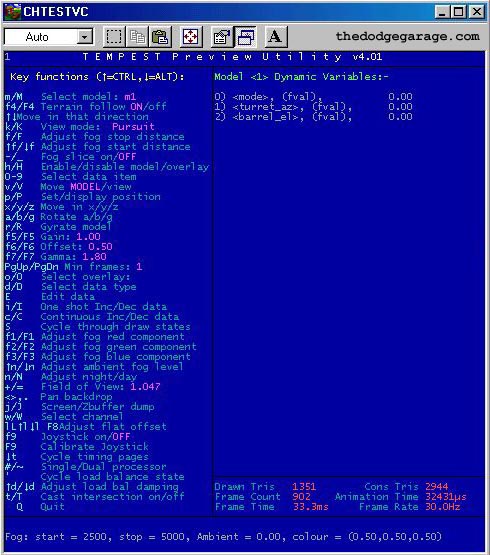
TEMPEST: Tempest is Primary Image's Application Programmer's Interface (API), capable of animating 3D worlds quickly and effectively. Tempest was specifically designed for the vis-sim industry and is easy to use so development costs are significantly reduced. Tempest has features such as large database management, known as Terrain Paging. This is the ability to animate databases of any size in real time making it possible to visualize huge area without sudden jumps, a common occurrence in other APIs. Other features include marine effects, continuously adaptive terrain, atmospheric effects, anti-aliased and calligraphic light points and multi-texture effects such as projected textures of landing lights. Tempest is fully compatible with Open GL and Direct X.
Notes from Paul Slade, former Primary Image employee: Primary Image rolled out Piranha in October 1997. This was a PCI board that had the following on it: - an embedded Mips R5000 200MHz processor that ran an embedded version of Glide driven by the client side part of the Tempest scene manager, the server side ran on the PC. The client side did all the cull/draw calculations thus relieving the PC's CPU of this burden and allowing multiple cards to be placed in a single PC (see below) - a Voodoo 1 FBI with 3 TMU's (to my knowledge this and the Barracudas are the only 3Dfx implementations by anyone to have 3 TMU's). This allowed for a tri-linear filtered base texture and a dithered trilinear filtered secondary texture, or even three dithered tri-linear textures in a single pass. - A daughter card with another Voodoo 1 FBI with another 3 TMU's. This was used in SLI mode with the set on the base card. The cards had a pixel bus connector system that allowed 2, 4 or 8 of them to be joined together and composited into a single channel to generate 2x, 4x or 8x rotated grid anti-aliasing. There were also tiling options so that half the cards could generate the left side of the screen and the other half the right side thus doubling the pixel fill rate and increasing the maximum resolution to 1280x1024. A second connector system was used to daisy chain the Pixel Clock, VSync and HSync signals, thus allowing multiple channels to be video synchronized. Industrial PC's were used which had up to 20 PCI slots in a 19 inch 6U rack mount chassis. The PC was a single board computer (SBC) that plugged into the end slot. This system was developed almost 2 years before Quantum3D debuted their 3Dfx based AA offering.
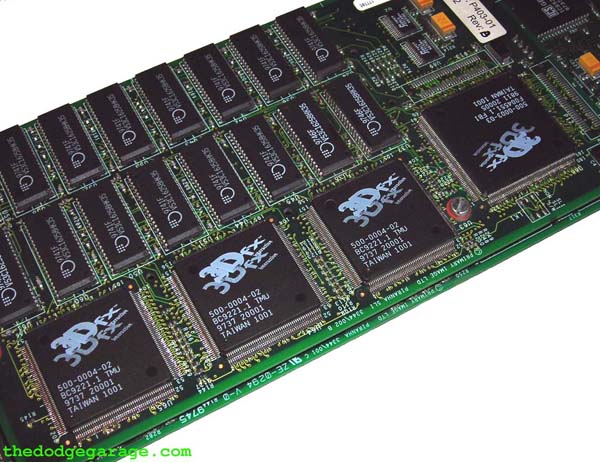
Close up of Piranha Voodoo Graphics chipset with 3 TMU's, 6 total with 64MB of ram.
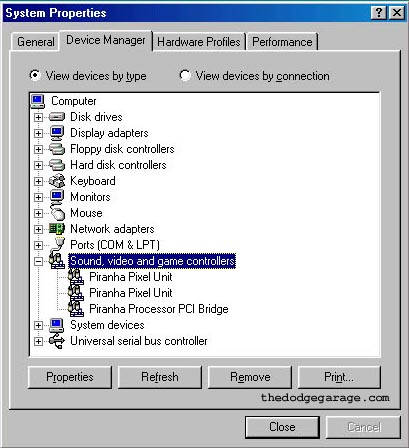
Properties in Windows 98SE
Screenshot showing a Tempest 1996 flight-simulator demo running, click for larger image!
Barracuda board up top, Cruncher on the bottom.
Notes from Paul Slade, former Primary Image employee: On the Barracuda board up top you can just make out the outline of the SLI daughter card - it covers pretty much the whole of the right half of the board. Underneath this card is an almost identical looking set of chips on the base card. The R7000 CPU was also on a daughter card at the bottom to the left of center. At the top you can see the extensive set of connectors used to connect multiple Barracudas and Cruncher. The connectors were themselves were flexible PCBs which daisy chained the boards together.
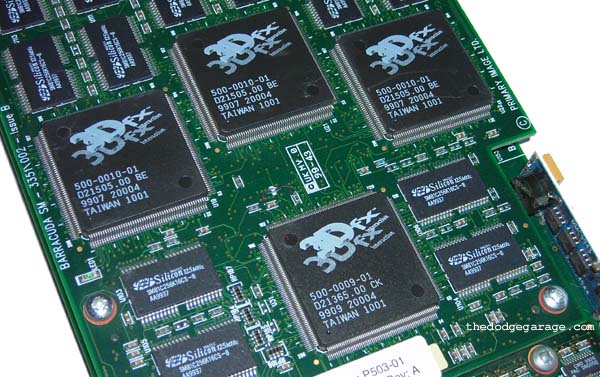
Close up of one of the Baracuda Voodoo II chipsets
Backside of both boards.
These are magnificent pieces of PC history based on a unique configuration of 3dfx hardware.
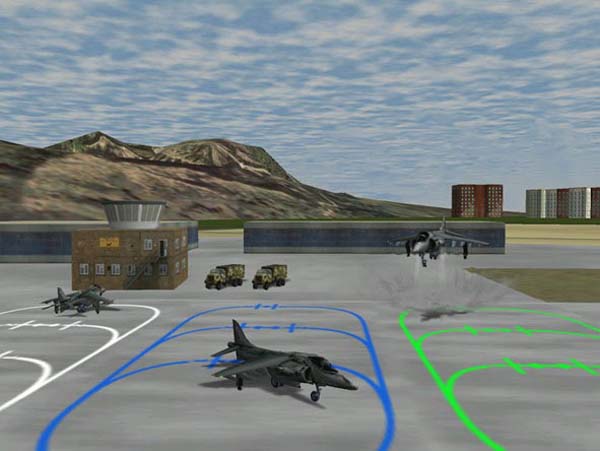
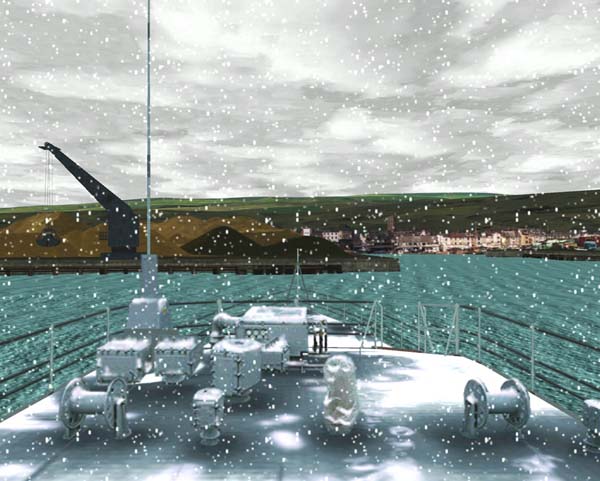
Some very cool 1999 vintage screenshots found on Primary Image website via webarchive.org